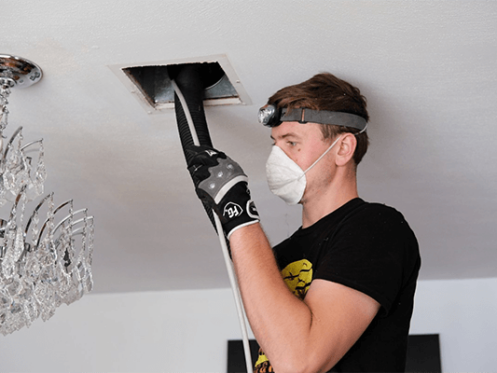Much like the recommendation to install dampers, I almost always emphasize adding a second return when replacing ductwork. During a major energy upgrade that we recently completed, we had two return ducts- a 14″ in the main house and a 12″ return duct in the master bedroom. That was for a 1.5 ton system and the static was 0.33 inches of water column (IWC). We went with smaller sized ducts for better insulation burial and higher velocity. The less time the cool air is in the hot attic the less heat gain.
Remember, statistically speaking, the bottleneck on high static pressure systems is on the return side. This can be caused by undersized returns, long return duct lengths (with bends or “sound attenuating loops”), or a poor choice of air filtration.
It was nice to see a package unit with new ductwork installed with a 2nd return added to the main area. Our return static on this job was only -0.225 IWC (much lower than those in the chart above) and our total static was about 0.5.
Not only is this good for system efficiency, it’s also a manufacturer requirement! We definitely don’t want to void the manufacturer warranty upon install…
As always, it also helps to put in the correct size system in relation to the home. Remember, less airflow means less pressure. If we put in a 4 ton instead of a 3 ton, we almost certainly would not have passed this performance metric.
If we’re putting a new furnace in a mechanical closet, and that closet is on a corner, we often have the opportunity to add a second return pathway in the drywall, as we did below.
In conclusion:
- Most HVAC systems have undersized return ducts, as evidenced by the Proctor study showing high static pressure on the return side.
- If you can hear air moving at your return, chances are you have an undersized return duct. This leads to high bills, annoying noise and pre-mature blower motor burnout- meaning decreased system durability.
- Adding a second return duct will fix all of these problems. In our pilot project, we had an 8″ in the master bedroom and a 14″ in the main house- and that’s only for a 1.5 ton system!
A second return duct can lower static pressure if the airflow bottleneck is on the return side. If the static is on the supply side, adding a second return will do nothing. So it’s usually a good idea.
Get in touch with the trusted team at Greiner Heating and Air to learn the best way to install this in Your home.
